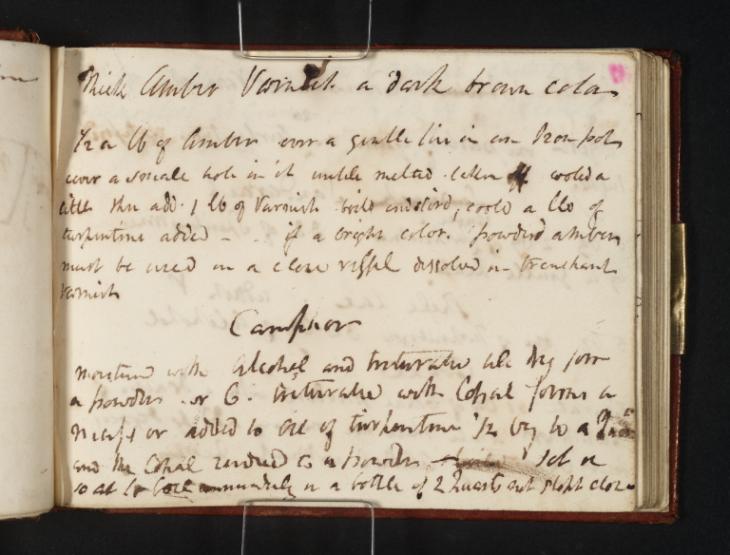Joseph Mallord William Turner Inscription by Turner: Notes from Nicholson's 'Dictionary of Practical and Theoretical Chemistry' c.1813
Joseph Mallord William Turner,
Inscription by Turner: Notes from Nicholson's 'Dictionary of Practical and Theoretical Chemistry'
c.1813
Joseph Mallord William Turner 1775–1851
Folio 61 Verso:
Inscription by Turner: Notes from Nicholson’s ‘Dictionary of Practical and Theoretical Chemistry’ c.1813
D09972
Turner Bequest CXXXV 61a
Turner Bequest CXXXV 61a
Pen and ink on white wove paper, 88 x 113 mm
Inscribed by Turner in ink with notes on chemistry (see main catalogue entry)
Inscribed by Turner in ink with notes on chemistry (see main catalogue entry)
Accepted by the nation as part of the Turner Bequest 1856
References
1909
A.J. Finberg, A Complete Inventory of the Drawings of the Turner Bequest, London 1909, vol.I, p.386, CXXXV 61a, transcribing part of inscription.
1992
Joyce H. Townsend, ‘Turner’s Writings on Chemistry and Artists’ Materials’, Turner Society News, no.62, December 1992, pp.7–8, with transcription.
2011
Matthew Imms, ‘Not “quite out of his province”? Some New Identifications of Turner’s Working Notes’, Turner Society News, no.116, Autumn 2011, p.4.
The whole page is taken up with recipes for varnishes:
Thick Amber Varnish a dark brown color
½ a lb of Amber over a gentle fire in an Iron pot | cover a small hole in it until melted. taken off coold a | little then add 1 lb of Varnish boild and stird, coold a lb of | turpentine added – – if a bright color. powderd amber | must be used in a close vessel dissolved in transparent | varnish
Camphor
Moistend with Alcohol and triturated till dry for a | powder [?for C.] triturate with Copal forms a | mass or added to Oil of turpentine ½ Oz to a Quart | and the Copal reduced to a powder <[?boild]> set on | so as to boil immediately in a bottle of 2 Quarts and | stopt close
This is one of fourteen pages of notes on varnishes and colours resulting from chemical reactions between folio 62 verso (D09974) and folio 55 recto (D09959), working from the back of the sketchbook as now foliated. As discussed in the sketchbook’s Introduction,2 most are taken from William Nicholson’s 1808 Dictionary of Practical and Theoretical Chemistry, in this case from the unpaginated entry on ‘Varnish’:
Of this sort is the amber-varnish. To make this varnish, half a pound of amber is kept over a gentle fire in a covered iron pot, in the lid of which there is a small hole, till it is observed to become soft, and to be melted together into one mass. As soon as this is perceived, the vessel is taken from off the fire, and suffered to cool a little; when a pound of good painter’s varnish is added to it, and the whole suffered to boil up again over the fire, keeping it continually stirring. After this, it is again removed from the fire; and when it is become somewhat cool, a pound of oil of turpentine is to be gradually mixed with it. Should the varnish, when it is cool, happen to be yet too thick, it may be attenuated with more oil of turpentine. This varnish has always a dark-brown colour, because the amber is previously half-burned in this operation; but if it be required of a bright colour, amber-powder must be dissolved in transparent painter’s varnish, in Papin’s machine by a gentle fire.
The paragraph headed ‘Champhor’ is a rather condensed reading from Nicholson’s entry on ‘Copal’ and its use in varnish:
In Gehlen’s Journal we are informed, that copal may easily be dissolved either in alcohol, or in oil of turpentine, by suspending bits of copal by threads over either of these in an alembic, and then boiling the fluid. The vapour liquefies the copal, which drops into the liquor beneath, and when cold the limpid and colourless solution is to be decanted from the undissolved part of the copal. Mr. Tim. Sheldrake has found, that camphor has a powerful action on copal; for if powdered copal be triturated with a little camphor, it softens, and becomes a coherent mass; and camphor added either to alcohol or oil of turpentine, renders it a solvent of copal. Half an ounce of camphor is sufficient for a quart of oil of turpentine, which should be of the best quality; and the copal, about the quantity of a large walnut, should be broken into very small pieces, but not reduced to a fine powder. The mixture should be set on a fire so brisk as to make the mixture boil almost immediately: and the vessel Mr. S. recommends to be of tin or other metal, strong, shaped like a wine-bottle with a long neck, and capable of holding two quarts. The mouth should be stopped with a cork, in which a notch is cut to prevent the vessel from bursting.
Matthew Imms
April 2014
How to cite
Matthew Imms, ‘Inscription by Turner: Notes from Nicholson’s ‘Dictionary of Practical and Theoretical Chemistry’ c.1813 by Joseph Mallord William Turner’, catalogue entry, April 2014, in David Blayney Brown (ed.), J.M.W. Turner: Sketchbooks, Drawings and Watercolours, Tate Research Publication, September 2014, https://www

